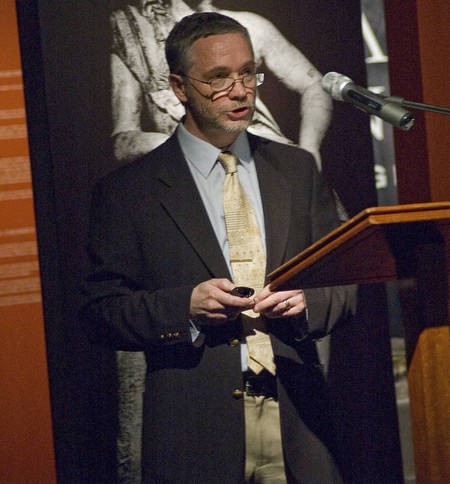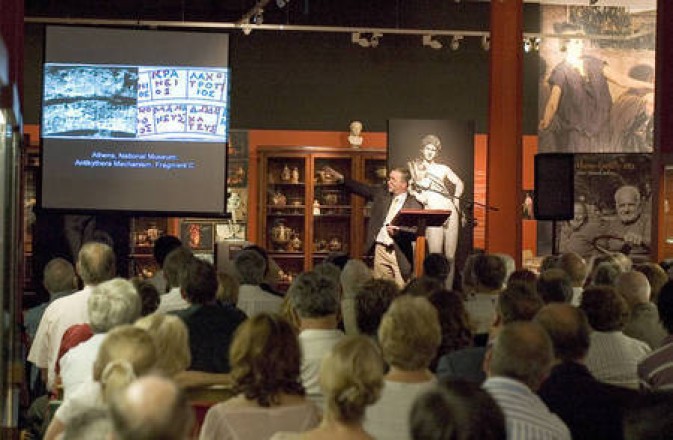Professor Robert Hannah, really warming up during his lecture
...at the Nicholson Museum, Sydney University, Thursday, 26th November, 2009.
The "patrons" of www.kythera-family.net look on approvingly, on the right hand side.

Archaeoastronomy at the Nicholson.
The Nicholson Museum at The University of Sydney was packed to the rafters Thursday evening for a fascinating presentation on one of the great mysteries of ancient Hellenism: the Antikythera Mechanism. Professor Robert Hannah, (Classics, University of Otago, New Zealand) delivered a great illustrated lecture on one of the world’s earliest computing devices. Prof. Hannah combined history, science and personal experience in a fascinating evening.
In 1901, a group of sponge fishermen from Symi recovered pieces of metal and wood from an ancient shipwreck off the coast of the island of Antikythera (in the strait between Peloponnesos and Krete. It was one of the first marine archaeological excavations. Since then, many scientists have examined the 82 fragments of the Mechanism in an effort to decode its secrets. What was it for? When was it created? How was it made? A century later, it stubbornly holds on to some of its secrets.
Going by the lettering on the Mechanism, it is commonly agreed that it was created sometime in the first century BC. Consisting of 30 interlocking bronze plates and several gears encased in wood about the size of a modern shoebox, it is commonly agreed that the Mechanism calculated the movement of stars and planets in order to determine important dates such as Panhellenic Games and other religious observances.
A number of aspects of the Antikythera Mechanism fascinate even the non-specialist. How did people more than two thousand years ago make mechanical instruments of such precision? The bronze plates and gears were all hand-carved! How did the ancient Hellenic scientists work out a method of ‘marrying’ three very different calendars: the Egyptian (365 days per year based on the sun), the Zodiac (based on the moon) and the Star Calendar (based on the movements of the stars and planets)? How did they develop a system of such precision that in this one device, three methods of measuring time were combined into one?
Dr Elizabeth Bollen served as Master of Ceremonies, with her usual grace, while George Poulos of the Life in Australia Launch Committee spoke about the coming re-launch of this historic volume. Originally produced in 1916, it will be re-launched at the MacLaurin Hall, University of Sydney on Wednesday 9 December, at 6:00pm.
The function was a combined effort of the Nicholson Museum and the Kytherian World Heritage Fund. This sort of collaboration between Australian Hellenic community organisations and university institutions sets a pattern of cooperation of mutual benefit and is a key way Australian Hellenism can support and encourage Hellenic studies in Australian institutions.
Dr Panayiotis Diamadis
President, Australian Hellenic Educators’ Association
Secretary, Australian Hellenic Council (NSW)
